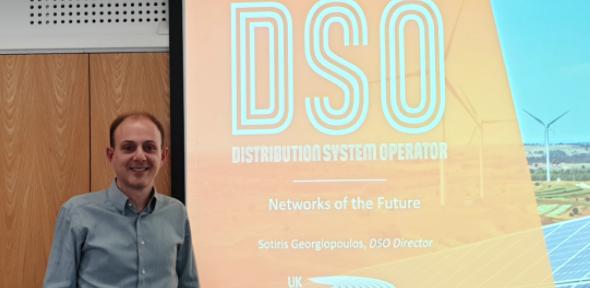
Sotiris Georgiopoulos, Director of Distribution System Operator, UK Power Network, joined the organisation in 2005 as a graduate engineer. He has worked in engineering, construction and innovation. For the last decade he has championed innovative ways to plan and operate our networks such as flexible connections and the development of flexibility markets.
By Shafiq Ahmed, Energy IRC
The UK’s electricity distribution system plays a crucial yet often unnoticed role, particularly as it adapts to the energy transition. This involves integrating renewables, electric vehicles (EVs), and heat pumps into the network. Key elements include infrastructure (wires, transformers, pylons), data-driven solutions, and digital technology to optimise the system and incentivise behaviours for a faster net-zero transition.
Electricity Distribution Overview
- UK Power Networks (UKPN) supports 20 million people (8.5 million households) across six regions, handling a third of UK energy consumption.
- Annual household contribution is £100 via energy providers.
- UKPN distribution covers:
- Household cut-out fuse.
- Low voltage (100k km of cables).
- High voltage (70k km of cables).
- Extra-high voltage (2,300 transformers).
- Transmission (8,500 km of cables, 300 grid supply points).
- Smart meter rollout by retailers has lagged by 10 years; distributor-led deployment would have been quicker.
Decarbonising the Power Supply
- UK has decarbonised the power supply sector, mainly by taking coal off the system.
- Current energy mix: 80% renewables, 20% fossil fuels. 13% of energy through interconnectors.
- UK aims for 95% clean energy by 2030 under the new NESO public body, requiring political will and public investment.
- Challenges include protests (e.g. over pylons in Suffolk), expanding battery storage (7GW today vs. 30GW needed), and addressing future infrastructure costs.
Future Energy Goals (By 2030)
- Solar PV: Increase from 5GW (2024) to 7.5GW.
- Energy storage: Increase from 1GW (2024) to 6GW.
- EVs: Rise from 1 million to 5 million.
- Heat pumps: Scale up from 0.1M to 0.6M.
Current Network Status and Choices
- Annual energy peak demand dropped from 16GW (2011) to 13.5GW (2023).
- The transition involves embracing digital tools, data, flexibility, and new renewable capacity.
Case Studies and Consumer Behaviour
- EV Smart Charging: Intelligent scheduling (e.g. Octopus Go tariff) reduced peak EV demand by 0.78kW during peak times, though shifted demand creates new peaks.
- Renewable Energy "Power Ups": Customers benefit from free energy during excess renewable generation.
- 24k customers enrolled across Cambridgeshire, Suffolk, and Norfolk
- 20MW demand increase over 54 events
- Consumer response to free energy is enthusiastic but risks overuse
Key Takeaways
- Billions of investment are needed for infrastructure upgrades.
- Consumer flexibility is growing, driven by incentives and digital innovations.
- Political will, public engagement, and strategic investment are essential to meet decarbonisation goals and address the evolving energy landscape.
|
Dr Shafiq Ahmed is the Energy Interdisciplinary Research Centre (Energy IRC) Coordinator at the University of Cambridge. The Energy IRC connects over 250 academics across the university who are working on energy research. By helping researchers connect across disciplines, the IRC develops teams working on larger-scale projects such as energy policy, energy efficiency, and sustainable energy. |



